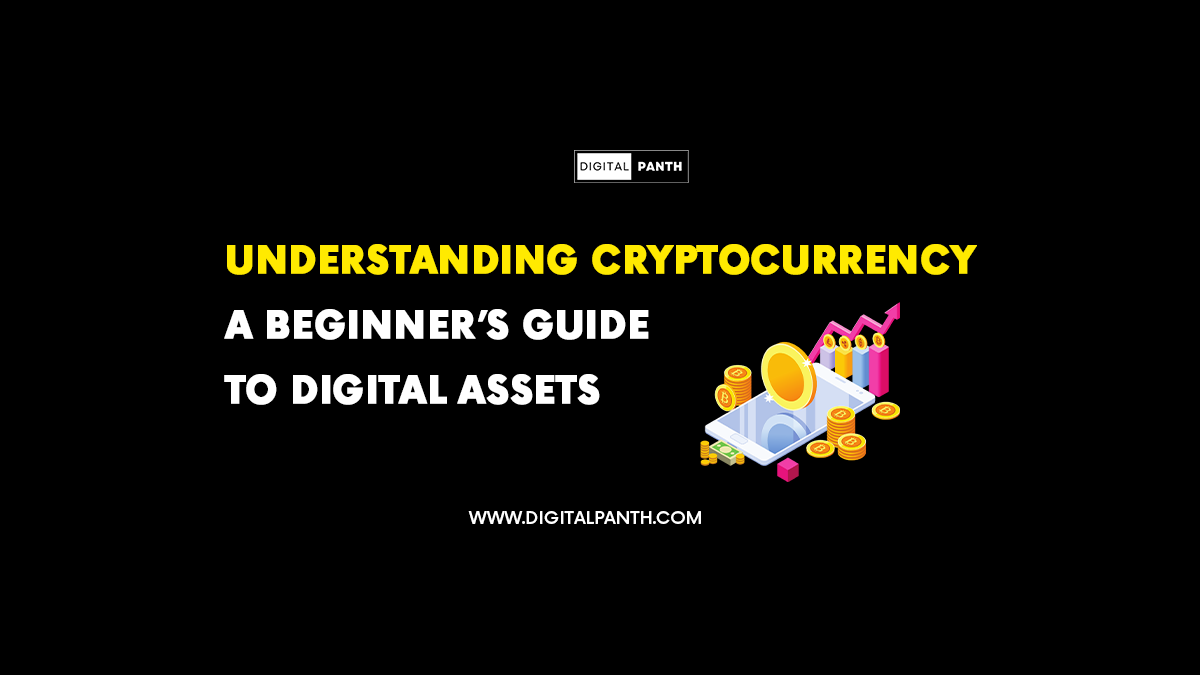Cryptocurrency and digital assets have revolutionized finance, technology, and investment. Over the past decade, they have gained mainstream acceptance, challenging traditional banking and monetary systems. While Bitcoin pioneered the space, thousands of cryptocurrencies and digital assets now exist, each with unique purposes and functionalities.
What is Cryptocurrency?
Cryptocurrency is a form of currency which is like a digital payment system. It operates independently, without having any control of any regulatory authority. This system or method does not need the help of banks for transaction verification. It’s a system which allows people to send and receive payments from anywhere directly to one another. It’s not like traditional currency that is physically sent and received in the financial world. Cryptocurrency payments are made independently as digital records are maintained in an online database which has details of each and every transaction. When you send or receive cryptocurrency, the transactions are maintained in a public ledger. Digital wallets store cryptocurrency.
Cryptocurrency has derived its name from the word ‘encryption’ which means changing electronic information into some secret codes. Encryption is used in Cryptocurrency to authenticate transactions. It means that secret coding is utilized for storing and transferring cryptocurrency information between wallets and public ledgers. The purpose of encryption is to ensure protection and security.
The key elements of cryptocurrency include:
• Decentralization: In cryptocurrency transactions, no single entity like a bank or government controls the network. Instead, transactions are verified through the number of participants or a consensus mechanism.
• Cryptographic Security: While making transactions of cryptocurrency, the transactions are encrypted, due to which there are very little chances of fraud and hacking.
• Consensus Mechanisms: Most cryptocurrencies use Proof of Work (PoW), which is a protocol for the security of digital transactions. Proof of Stake (PoS) is another consensus mechanism to validate transactions and secure the network.
Bitcoin uses PoW to solve complex mathematical problems for the validation of transactions and adding them to the blockchain. Ethereum is shifting from PoW to PoS which allows validators to secure the network by staking their cryptocurrency holdings.
Categories of Cryptocurrency.
1. Payment cryptocurrency: Bitcoin is mainly used for the payment of cryptocurrency. It is often called “digital gold”. It is mainly used for wealth preservation and as a hedge against inflation.
2. Utility Tokens: Ethereum is a cryptocurrency, which is a type of utility token which is used for smart contracts and self-executing contracts and operates without intermediaries. Other platforms like Solana, Cardano, and Polkadot also support decentralized applications (DApps).
3. Stablecoins: Stablecoins is another category of cryptocurrency. Under this category, there are many cryptocurrencies, including Tether (USDT), USD Coin (USDC), and DAI. They give stability to the price of cryptocurrency, making them useful for transactions and savings.
4. Central Banks Digital Currencies (CBDC): Central Bank Digital Currency is a category of cryptocurrency which is released by the central banks of different nations. CBDCs are released by central banks with a digital record linked to the currency and tied to the local currency of the country or area that issues them.
How does cryptocurrency work?
There is a method of generating cryptocurrency units which is known as mining. This mining system utilizes computer power to solve intricate mathematical calculations to produce coins. Users can additionally purchase the currencies from brokers, after which they can store and utilize them with cryptographic wallets.
Cryptocurrencies rely on blockchain technology, which is a decentralized digital ledger that records all transactions across a network of computers. Cryptocurrency operates on a decentralized public ledger which is known as blockchain. The blockchain is a record of every transaction done and updated by the cryptocurrency holders. Cryptocurrencies rely on blockchain technology, which is a decentralized digital ledger that records all transactions across a network of computers.
If you possess cryptocurrency, it means that you have a digital asset and you will be having a key that enables you to transfer a record or a unit of cryptocurrency from one individual to another without using any intermediary.
Cryptocurrency as a Digital Asset.
A digital asset is kept in electronic form and can be purchased, sold, owned, moved, or exchanged. Digital assets like cryptocurrencies and various applications powered by blockchain technology have become widespread. Investments in cryptocurrencies and their related services are on the rise.
A cryptocurrency is a digital or virtual currency secured by cryptography, making it nearly impossible to commit any fraud. Cryptocurrency is totally different from traditional currencies which are issued by governments.
Blockchain is the technology that allows for the existence of cryptocurrency. A cryptocurrency is used as a digital asset and employs cryptographic methods and its own protocol to authenticate fund transfers and manage the creation of monetary units.
Bitcoin was introduced in 2009; after that, thousands of cryptocurrencies, as Ethereum, Binance Coin, and Solana, have emerged, offering various features and uses. Bitcoin was the first cryptocurrency. It was used for a decentralized, peer-to-peer financial system which was considered to operate without intermediaries like banks.
Bitcoin is the most well-known cryptocurrency, for which blockchain technology was developed. Blockchain technology is still developing in financial markets which is anticipated to be used with additional features in the future. Trading in bonds, stocks, and various financial assets may be conducted with the help of this technology.
How to purchase cryptocurrency?
When you go for purchasing cryptocurrency, generally, there are three stages. Here they are:
Step 1: Selecting a platform
The first step is to choose the platform to use for the purchase of cryptocurrency. Typically, you can opt for either a conventional broker or a specialized cryptocurrency exchange-
• Conventional brokers – These are online brokerage firms which provide the facility of purchasing and trading cryptocurrency. Trading can be done with many financial instruments, such as stocks, bonds, and ETFs. These platforms usually provide reduced trading expenses but have fewer cryptocurrency features.
• Digital currency trading platforms – Numerous cryptocurrency exchanges are available, each presenting various cryptocurrencies, wallet storage solutions, interest-earning account options, and additional features. Numerous exchanges impose fees based on assets.
When you go for choosing among the various platforms, always make sure that the cryptocurrencies are available. Also collect information about the fees imposed, the security measures, storage and withdrawal choices, as well as any educational materials provided.
Step 2: Adding funds to your account
After selecting your platform, the next step is to deposit funds into your account to start trading. Most crypto exchanges enable users to buy cryptocurrency with fiat which is a government-issued currency as the US Dollar, the British Pound, or the Euro. The users can buy cryptocurrency through their debit or credit cards, though this can differ between platforms.
Buying crypto through credit cards is risky and that is why several exchanges do not allow them. Certain credit card providers also don’t allow crypto transactions. This is due to the significant volatility of cryptocurrencies.
An important point to be considered is costs. This includes possible charges for deposit and withdrawal transactions with trading fees. Charges differ on the basis of the payment method and platform, so it’s important to investigate this before making any transaction.
Step 3: Submitting an order
The third step while purchasing cryptocurrency is to submit an order through your broker’s or exchange’s website or mobile application. If you want to purchase cryptocurrencies, you should select the “buy” option and pick the order type, then enter the number of cryptocurrencies you have to purchase. At last confirm the order. The similar procedure is used for “sell” orders.
Other methods of investment in cryptocurrency.
There are some other options to invest in cryptocurrency besides purchasing. If you want to have digital assets in cryptocurrency, the investment options are:
• Bitcoin trusts: You can purchase shares of Bitcoin trusts using a brokerage account. These vehicles provide retail investors access to cryptocurrency through the stock market.
• Bitcoin mutual funds: You have an options of investing in Bitcoin mutual funds. This is also a good digital asset.
• Blockchain stocks or ETFs: You can invest in cryptocurrency indirectly by buying shares in blockchain companies whose focus is on the technology supporting cryptocurrency and its transactions. You can purchase shares or ETFs from the companies which utilize blockchain technology.
Benefits of Cryptocurrency as Digital Assets.
Cryptocurrencies and digital assets offer several advantages over traditional financial systems:
1. Decentralization and Financial Inclusion: If you have cryptocurrency or you trade in it as your digital assets, you do not have to rely on any intermediaries. Cryptocurrencies enable financial access to those people who don’t have bank accounts in any of the countries worldwide.
2. Transparency and Security Blockchain’s ledger ensures transaction integrity, as it is unchangeable and reduces fraud and corruption.
3. Lower Transaction Costs: With the use of cryptocurrency, cross-border transactions often become cheaper and faster than traditional banking methods.
4. Ownership and Control: If you have cryptocurrency as digital assets, you have direct control over your assets which reduces dependency on banks and third parties.
5. Programmability and Automation With the help of cryptocurrency, smart contracts can take place, as automated transactions can be executed which reduces administrative costs and human errors.
Risk and Challenges.
Despite the benefits of cryptocurrencies and digital assets, some significant challenges are also there:
1. Regulatory Uncertainty All over the world, the governments are still developing regulations for cryptocurrencies which are creating uncertainties for businesses and investors.
2. Market Volatility: The prices of cryptocurrencies are highly volatile which is a great cause of potential losses for investors.
3. Security Risks While blockchain is secure, there are security risks in exchanges, wallets, and smart contracts, as they all are vulnerable to hacking and scams.
4. Stability Issues: Many blockchain networks face problems with transaction speed and high fees which become a cause to limit their adoption by the mainstream.
Bottom Line.
Cryptocurrencies and digital assets are reshaping the finance. They provide decentralization, security, and innovation, but on the other end, they are risky. Ongoing technological advancements and regulatory developments will possibly shape their future. As the investors’ adoption increases, these digital assets could redefine how people transact, invest, and interact in the digital economy.



Leave feedback about this